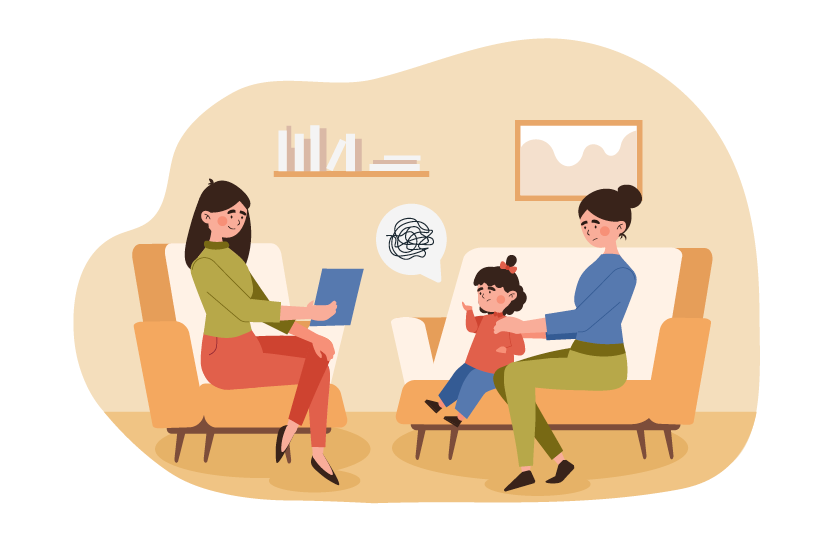Traumatic events affect children in different ways, but therapy can help them heal.
According to the Substance Abuse and Mental Health Services Administration (SAMHSA), two-thirds of children experience a traumatic event by the age of 16. Sadly, there is no age immune to the impacts of trauma.
It’s vital we understand what are considered traumatic events, recognize the signs children exhibit (though they vary in age and developmental stage), and know what treatments are available to support those affected.
Children experiencing trauma responses may have experienced:
- Physical or emotional bullying
- Involvement in an accident
- Natural disasters
- Sexual abuse or exploitation
- Terrorism
- Community violence
- Serious illness
- Physical abuse
- Witnessing domestic violence
- Neglect
- Grief or coping after the death of a loved one
 Recognizing Signs of Traumatic Stress in Children
Recognizing Signs of Traumatic Stress in Children
A child may exhibit symptoms of traumatic stress when they are triggered by something that reminds them of the traumatic event. And while everyone exhibits reactions to stress, traumatic stress can manifest in ways that interfere with a child’s daily life and how they relate to those around them. Some signs include:
- Intense episodes or ongoing emotional upset
- Depression and anxiety
- Regressing in established skills
- Nightmares and trouble sleeping
- Difficulties self-regulating
- Poor eating and weight loss
- Displaying feelings of guilt or shame
- Struggling to form attachments or relate to others
- Older children may exhibit risky behavior in the form of drug or alcohol use, as well as unhealthy sexual activity
Treating Trauma with Therapy
Treatment can help children understand their traumatic responses and identify triggers, as well as decrease their stress symptoms, develop healthy coping skills, re-establish safety, and process their experience so their related memories and emotions are less disruptive. There are different therapeutic approaches to treating trauma.
Trauma-Focused Cognitive Behavioral Therapy
Trauma-Focused Cognitive Behavioral Therapy (or TF-CBT) understands parents and/or caregivers significantly impact a child’s trauma response, and this treatment approach can sometimes require their participation. In those instances, it typically begins with separate sessions for the child and parent (non-offending parent in cases of abuse) before moving into joint sessions.
TF-CBT aims to help the child modify distorted thinking, overcome negative behaviors, challenge invasive thoughts, restore a sense of safety and security, and empower the parent or caregiver to better help the child going forward. TF-CBT incorporates several core features and techniques, including psychoeducation (teaching normal reactions to traumatic experiences), coping skills, gradual exposure, cognitive processing for regulating emotions, and rebuilding trust in relationships with adults.
Prolonged Exposure Therapy
It’s common for children who’ve experienced trauma to try and shut out their memories and avoid any feelings associated with it, but that can hinder their ability to heal. Prolonged exposure therapy focuses on approaching traumatic memories gradually to decrease PTSD symptoms and responses over time.
EMDR
The goal of EMDR, which stands for eye movement desensitization and reprocessing, is to overwrite the earlier, unprocessed version of an event’s memory and put it into context — making it something that’s remembered rather than relived.
EMDR involves having the child focus on the traumatic event and accompanying memories while simultaneously experiencing bilateral stimulation (such as eye movements). This can reduce the intensity and emotion surrounding the memory. EMDR treatment can be tailored to the child, but it works best for those who experienced a trauma with a clear beginning and end (an accident, for example).
Art Therapy
Art therapy is another approach that can help children process trauma in a way that makes them more comfortable expressing themselves, boosts their self-esteem, and even improves cognitive and sensory-motor functioning in young children.
Play Therapy
Play therapy is an approach for working through a child’s trauma because by allowing the child to express and communicate in a way that feels natural. The act of play is a fundamental component of children’s growth and expression, so it can have a therapeutic impact and feel more natural when they use it to address difficult topics.
While the memories of a traumatic event will remain after therapy, they can have less control over children’s everyday lives, and healthy coping skills can help them succeed and thrive moving forward.
Sources:
https://www.nctsn.org/
https://www.samhsa.gov/child-trauma/understanding-child-trauma
https://www.samhsa.gov/child-trauma/recognizing-and-treating-child-traumatic-stress
https://cctasi.northwestern.edu/trauma-focused-therapy/
https://www.ncbi.nlm.nih.gov/pmc/articles/PMC8812369/
https://www.ncbi.nlm.nih.gov/pmc/articles/PMC4476061/
https://childmind.org/article/emdr-therapy-for-childhood-trauma/
https://www.ncbi.nlm.nih.gov/pmc/articles/PMC7163896/
